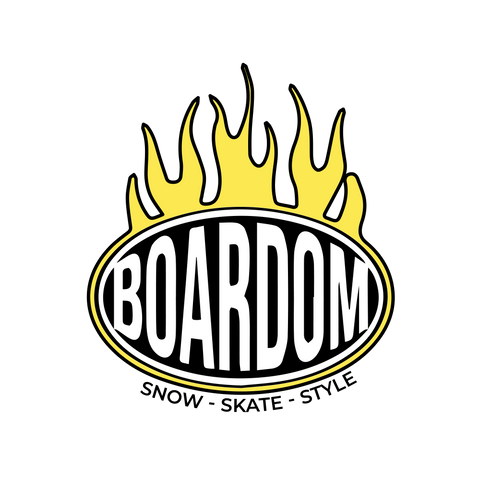Are you looking to buy a skateboard for the first time?
Or are you just curious about how your skateboard is put together?
For first-time buyers, the process of purchasing a skateboard can be confusing and stressful. This is why Boardom wants to break down the anatomy of a skateboard so you’ll know exactly what you’re buying.
But if you already own a skateboard, knowing how it is put together is helpful as well!
So let’s look at the anatomy of a skateboard and how each of these parts work together to give you the smoothest and fastest ride:
Deck
The skate deck is the flat board that you stand on when skateboarding. The shape and size of the deck depend on the type of skateboard you are using (i.e., a skateboard versus a longboard).
The board is a wooden platform with trucks mounted to the bottom and grip tape applied to the top to provide traction. The ply is a layer of wood or fiberglass and is used to measure its thickness. Laminates are the glues that stick one ply to another.
As far as the shape of the deck goes, the nose of the board is the front kicktail of the skateboard and is usually broader than the tail which is the back kicktail.
On the deck, you’ll also find eight mounting holes (four near each kicktail) in order to attach the truck. The distance between the inside mounting holes is called the wheelbase and measures the distance between the trucks.
Truck
We’ve mentioned the truck but let’s look at this skateboard part in more detail:
The truck contains a part called the axle. The axle is a metal rod that runs through the truck hanger and protrudes a couple of inches on each side. The truck hanger is the piece that is fastened to the kingpin and rests in the pivot cup of the base plate. It also contains the axle on which the wheels are mounted.
The kingpin is a partially threaded bolt that protrudes from the base plate and supports the bushing and truck hanger. It is here that the axle nut can be loosened or tightened to adjust the turning capacity of the truck.
The bushings are donut-shaped urethane pieces inside the kingpin. Adjusting the kingpin nut will tighten or loosen the bushing and adjust the turning capacity of the truck.
The base plate is the component of the truck that is attached to the board with the mounting hardware. It includes the plate, the kingpin, and the pivot cup. The pivot cup is a plastic cup-shaped piece that rests on the base plate and supports the truck hanger at the pivot point.
Wheels
The wheels are also an important part of your skateboard and are comprised of a bearing seat and a core.
The core of the wheel is the centre piece where the bearing is inserted. Some wheels are made of a higher durometer (the hardness measurement of a material) urethane to increase durability and decrease weight.
Bearings
The bearing seat is part of the wheel’s core and keeps the bearing vertically positioned and centered inside the wheel.
The bearing itself is an intricate component of your skateboard’s wheel. It’s the piece that allows for the rolling motions of a wheel on its axle and consists of 6-8 small balls enclosed in a disk-like body.
The Delrin crown holds and separates the individual balls, keeping them lubricated and clean so you can extend the life and strength of your bearings. A bearing also has a bearing shield held in place by a bearing c clip on the side to keep dirt from getting in and the ball bearings from falling out.
Riser Pads
Riser pads are plastic or soft rubber pads that help to add space between the trucks of the deck. These are not required pieces on a skateboard but can help absorb some of the impact on the board and avoid pressure cracks.
Riser pads can also help you avoid wheel bite, which occurs when a while comes into contact with the deck during a turn and stops. This can cause you to lose balance and/or fall off the board.
Hardware
The hardware of a skateboard are the pieces that hold all of the other items together to create the skateboard. These include nuts and bolts that attach the trucks and riser pads to the skateboard deck.
Standard skateboard hardware includes 8 bolts and 8 nuts and is commonly ⅞” with no risers and 1” with risers. The size of the hardware should be sufficient to put together most skateboard set-ups.
Protective Gear
While protective gear is not technically part of a skateboard’s anatomy, it’s a crucial component when it comes to riding your skateboard safely.
Apart from choosing the skateboard that is right for you, you’ll need to purchase protective measures including a helmet that fits well, wrist guards, knees and elbow pads, and closed-toe shoes that have slip-proof soles.
When it comes to skateboarding, you’re going to fall at some point. Knowing how to fall properly can also help you prevent injuries. If you’re a first-time boarder, practice falling on a soft surface and focus on landing on the fleshy parts of your body (avoid breaking a fall with your arms and hands).
Check out our protective gear.
The Anatomy of a Skateboard: Choosing the Perfect Board
Choosing a skateboard depends entirely on what your boarding goals are. Are you interested in hitting up the skate parks to do tricks? Or are you looking to cruise around Edmonton?
Either way, understanding the components of your skateboard is the first step in ensuring that you buy the perfect board to suit your needs!
For more than 14 years, Boardom has been passionate about skateboarding and our friendly, knowledgeable staff is happy to assist you in finding that perfect board.
If you have any questions, please feel free to contact us!

